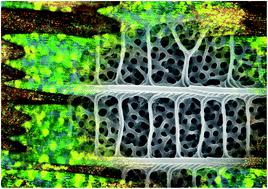当前位置:
X-MOL 学术
›
Faraday Discuss.
›
论文详情
Our official English website, www.x-mol.net, welcomes your
feedback! (Note: you will need to create a separate account there.)
Quo vadis biophotonics? Wearing serendipity and slow science as a badge of pride, and embracing biology
Faraday Discussions ( IF 3.3 ) Pub Date : 2020-10-09 , DOI: 10.1039/d0fd00108b Gerd E Schröder-Turk 1
Faraday Discussions ( IF 3.3 ) Pub Date : 2020-10-09 , DOI: 10.1039/d0fd00108b Gerd E Schröder-Turk 1
Affiliation

|
This article is a reflection on the themes of the Faraday Discussion meeting on ‘Biological and bio-inspired optics’ held from 20 to 22 July 2020. It is a personal perspective on the nature of this field as a broad and interdisciplinary field that has led to a sound understanding of the material properties of biological nanostructured and optical materials. The article describes how the nature of the field and the themes of the conference are reflected in particular in work on the 3D bicontinuous biophotonic nanostructures known as single gyroids and in bicontinuous structures more broadly. Such single gyroid materials are found for example in the butterfly Thecla opisena, where the questions of biophotonic response, of bio-inspired optics, of the relationship between structure and function, and of the relationship between natural and synthetic realisations are closely interlinked. This multitude of facets of research on single gyroid structures reflects the beauty of the broader field of biophotonics, namely as a field that lives through embracing the serendipitous discovery of the biophotonic marvels that nature offers to us as seeds for in-depth analysis and understanding. The meandering nature of its discoveries, and the need to accept the slowness that comes from exploration of intellectually new or foreign territory, mean that the field shares some traits with biological evolution itself. Looking into the future, I consider that a closer engagement with living tissue and with the biological questions of function and formation, rather than with the materials science of biological materials, will help ensure the continuing great success of this field.
中文翻译:

Quo vadis 生物光子学?将偶然发现和缓慢的科学作为骄傲的徽章,拥抱生物学
本文是对2020 年 7 月 20 日至 22 日举行的“生物和仿生光学”法拉第讨论会主题的反思。深入了解生物纳米结构和光学材料的材料特性。文章描述了该领域的性质和会议的主题如何特别反映在 3D 双连续生物光子纳米结构(称为单陀螺仪)和更广泛的双连续结构的工作中。例如在蝴蝶Thecla opisena中发现了这种单一的 gyroid 材料,其中生物光子响应、仿生光学、结构与功能之间的关系以及自然与合成实现之间的关系密切相关。单陀螺结构研究的众多方面反映了更广泛的生物光子学领域的美丽,即作为一个通过拥抱自然提供给我们的生物光子奇迹的偶然发现作为深入分析和理解的种子而生存的领域。其发现的曲折性质,以及需要接受来自知识新领域或外国领域探索的缓慢性,意味着该领域与生物进化本身具有一些共同特征。展望未来,
更新日期:2020-10-11
中文翻译:

Quo vadis 生物光子学?将偶然发现和缓慢的科学作为骄傲的徽章,拥抱生物学
本文是对2020 年 7 月 20 日至 22 日举行的“生物和仿生光学”法拉第讨论会主题的反思。深入了解生物纳米结构和光学材料的材料特性。文章描述了该领域的性质和会议的主题如何特别反映在 3D 双连续生物光子纳米结构(称为单陀螺仪)和更广泛的双连续结构的工作中。例如在蝴蝶Thecla opisena中发现了这种单一的 gyroid 材料,其中生物光子响应、仿生光学、结构与功能之间的关系以及自然与合成实现之间的关系密切相关。单陀螺结构研究的众多方面反映了更广泛的生物光子学领域的美丽,即作为一个通过拥抱自然提供给我们的生物光子奇迹的偶然发现作为深入分析和理解的种子而生存的领域。其发现的曲折性质,以及需要接受来自知识新领域或外国领域探索的缓慢性,意味着该领域与生物进化本身具有一些共同特征。展望未来,











































 京公网安备 11010802027423号
京公网安备 11010802027423号